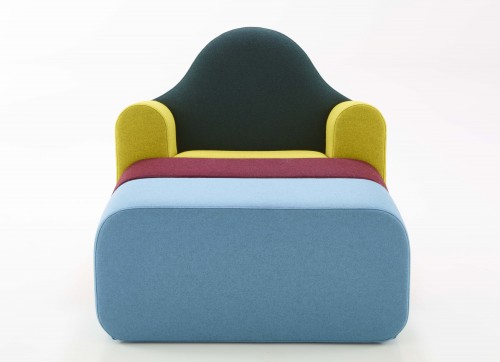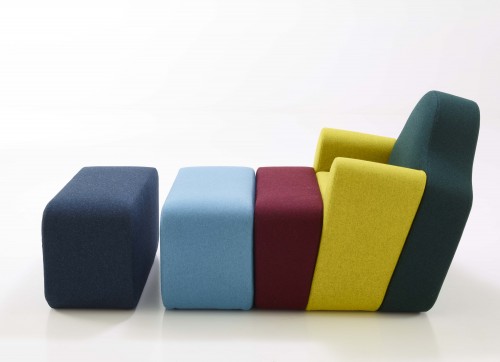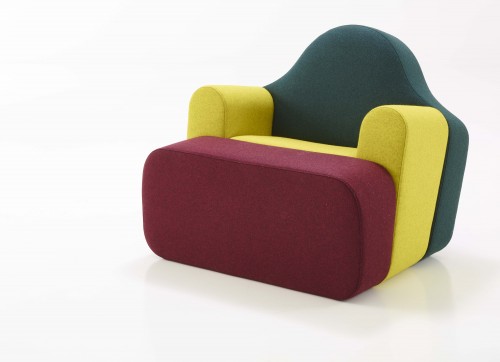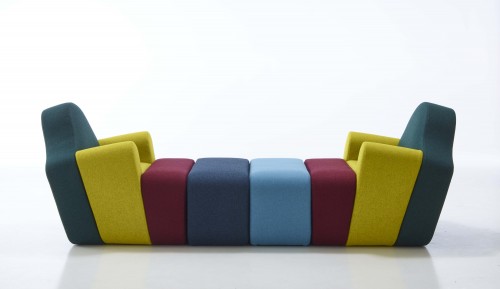Slice is almost 20 years old.
So, it’s just the right time for a little history.
Sketched out in 1996 and produced by Cinova in 1998, its production and distribution remained, at this time, at a level which could well qualify as confidential.
The galerie Kreo took charge of distribution in 1999, thus helping it become known, inserting its colourful image into the vast ‘landscape’ of contemporary design in the early years of the new millennium.
Cinna’s happy decision to reissue Slice today, in a version with re-evaluated comfort, gives this model a whole new lease of life whilst remaining in tune with the project’s original intentions: to offer an accessible form of seating which is at once classic in shape, its lines clearly evoking the Club armchair, and contemporary in use, with the possibility of adding footstools to vary the dimensions of its seat – perhaps infinitely, if one were to let one’s imagination break through the boundaries imposed by the domestic spaces in which we live.
This deconstruction by slicing assumes a link between Slice and a whole line of padded seating which runs from Pierre Paulin’s ABCD to Joe
Colombo’s Additional Living Système, via Achille Castiglioni’s Cubo or Sancarlo armchairs, in which the juxtaposition of foams of different densities brings forth an entirely new type of comfort, one which is more‘responsive’ than soft. But in the case of Slice, this structural deconstruction also offers, perhaps most importantly, the possibility of confronting oneself with another type of infinity, one which is just as dizzying, that of colour combination, a way in which every one of us can express themselves.
If there is no doubt at all that Slice is a seat, it is also an object the intention of which is to invite us to live with colour. An invitation to bask
in it, perhaps even to lose oneself in it.
Pierre Charpin, December 2015
Le Slice a presque 20 ans.
L’occasion de faire un peu d’histoire donc.
Esquissé en 1996 et édité par Cinova en 1998, sa production comme sa diffusion sont restées pendant toutes ces années à une échelle que l’on peut qualifier de confidentielle.
C’est la galerie Kreo qui à partir de 1999 prendra en charge sa diffusion et contribuera ainsi à le faire connaitre, inscrivant son image colorée dans le vaste “paysage” du design contemporain des années 2000.
La décision de Ligne Roset de rééditer aujourd’hui le Slice, dans une version au confort ré-évalué, laisse envisager une nouvelle vie à ce modèle, davantage en phase avec les intentions d’origine du projet: proposer une assise accessible, à la fois classique dans sa forme par l’évocation évidente du fauteuil Club, et contemporaine dans son usage par l’addition de poufs qui permettent de faire varier la dimension d’assise, jusqu’à l’infini même, si on laisse notre imaginaire franchir les limites des espaces domestiques que nous habitons.
La décomposition par tranches rattache de façon assumée le Slice à une lignée de rembourrés qui vont de la série ABCD de Pierre Paulin à l’Additional Living Système de Joe Colombo en passant par le fauteuil Cubo ou Sancarlo d’Achille Castiglioni, où l’utilisation par juxtaposition de mousses d’intensités différentes a permis un nouveau type de confort, confort plus “nerveux” que moelleux.
Mais dans le cas du Slice, cette décomposition structurelle offre aussi et surtout la possibilité de se confronter à une autre infinité, toute aussi vertigineuse, celle du jeu de la combinaison des couleurs, auquel chacun peu s’adonner pour exprimer sa sensibilité.
S’il ne fait aucun doute que le Slice est bien une assise, c’est aussi un objet qui a pour projet de nous inviter à vivre avec la couleur. Une invitation à se prélasser, peut être même à s’oublier dans la couleur.
Pierre Charpin, Décembre 2015







